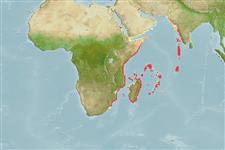Environment: milieu / climate zone / depth range / distribution range
Ecologia
marino associati a barriera corallina. Tropical
Western Indian Ocean: Kenya and Mozambique to islands in the western Indian Ocean.
Size / Peso / Age
Maturity: Lm ? range ? - ? cm
Max length : 21.0 cm SL maschio/sesso non determinato; (Ref. 3503); common length : 20.0 cm TL maschio/sesso non determinato; (Ref. 5450)
Spine dorsali (totale) : 12; Raggi dorsali molli (totale) : 9; Spine anali: 3; Raggi anali molli: 5. A black spot nearly as large as eye on inner surface of pectoral fins near base of first 5 rays; no black mark inside mouth at front of upper jaw. Ascending process of premaxilla narrow, its maximum width 1.8-2.2 in orbit diameter; a series of papillae or nodules (sometimes on a low ridge) across interorbital space between supraocular spines; nasal spine single (Ref 42181).
Usually found immobile at the bottom camouflaged among rocks and coral. Hunts by ambushing prey (Ref. 5503). Unlike most scorpaenids, the sting from the dorsal spines of this species can be painful but does not pose any real danger to the victim (Ref. 5503). Sold fresh in small quantities in markets.
Life cycle and mating behavior
Maturities | Riproduzione | Spawnings | Egg(s) | Fecundities | Larve
Randall, J.E and W.N. Eschmeyer, 2001. Revision of the Indo-Pacific scorpionfish genus Scopaenopsis, with descriptions of eight new species. Indo-Pac. Fish. (34):79 p. (Ref. 42181)
IUCN Red List Status (Ref. 130435)
Threat to humans
Traumatogenic (Ref. 5503)
Human uses
Pesca: scarso interesse commerciale
Strumenti
Special reports
Download XML
Fonti Internet
Estimates based on models
Preferred temperature (Ref.
123201): 25 - 28.9, mean 27.2 °C (based on 444 cells).
Phylogenetic diversity index (Ref.
82804): PD
50 = 0.5000 [Uniqueness, from 0.5 = low to 2.0 = high].
Bayesian length-weight: a=0.01259 (0.00606 - 0.02615), b=3.03 (2.86 - 3.20), in cm total length, based on LWR estimates for this (Sub)family-body shape (Ref.
93245).
Trophic level (Ref.
69278): 4.2 ±0.73 se; based on food items.
Resilienza (Ref.
120179): Medio, tempo minimo di raddoppiamento della popolazione 1.4 - 4.4 anni (Preliminary K or Fecundity.).
Fishing Vulnerability (Ref.
59153): Low vulnerability (16 of 100).
Nutrients (Ref.
124155): Calcium = 61.9 [32.2, 128.5] mg/100g; Iron = 0.667 [0.347, 1.661] mg/100g; Protein = 18.1 [16.1, 20.1] %; Omega3 = 0.232 [0.101, 0.641] g/100g; Selenium = 27 [14, 69] μg/100g; VitaminA = 256 [83, 745] μg/100g; Zinc = 1.19 [0.80, 1.75] mg/100g (wet weight);
